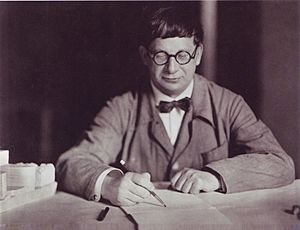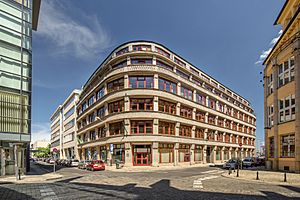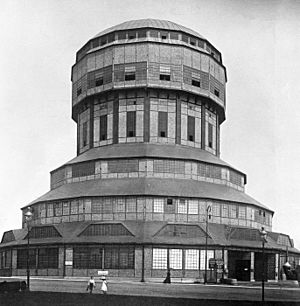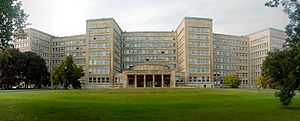Hans Poelzig facts for kids
Quick facts for kids
Hans Poelzig
|
|
|---|---|

Hans Poelzig (1927)
|
|
| Born | 30 April 1869 |
| Died | 14 June 1936 (aged 67) Berlin
|
| Nationality | German |
| Occupation | Architect |
| Buildings | I.G. Farben Building Großes Schauspielhaus |
| Projects | Palace of the Soviets Film sets for The Golem |
Hans Poelzig (born April 30, 1869 – died June 14, 1936) was a famous German architect. He was also a painter and designed sets for movies and plays.
Contents
Life of Hans Poelzig
Hans Poelzig was born in Berlin in 1869. He was raised by a local choirmaster and his wife. In 1899, he married Maria Voss, and they had four children together.
Hans Poelzig was buried in the Old Cemetery in Berlin-Wannsee. In 2015, a memorial was opened in Berlin to honor him and other founders of the Friedrichstadt-Palast theatre.
Hans Poelzig's Education
In 1903, Poelzig became a teacher and director. He worked at the Breslau Academy of Art and Design. Later, from 1920 to 1935, he taught at the Technical University of Berlin. He also led the Architecture Department of the Prussian Academy of Arts in Berlin.
Hans Poelzig's Career
After finishing his studies, Hans Poelzig designed many industrial buildings. In 1911, he designed the tall Upper Silesia Tower in Posen (now Poznań). This tower was 51.2 meters (about 168 feet) high and later became a water tower.
In 1916, he became the city architect of Dresden. He was an important member of the Deutscher Werkbund, a group of artists and designers.
Poelzig was also known for his work on the Berlin Grosses Schauspielhaus in 1919. He redesigned the inside of this theatre for Max Reinhardt. He also created huge building designs for the 1920 film The Golem: How He Came Into The World.
Hans Poelzig's work changed over time. He started with a style called Expressionism. Then he moved to New Objectivity in the mid-1920s. Later, his style became more simple and practical.
In 1927, he showed his work at the first International Style project. This was the Weissenhof Estate in Stuttgart. In the 1920s, he ran "Studio Poelzig" with his wife, Marlene.
Poelzig also designed the 1929 Broadcasting House in Charlottenburg, Berlin. This building is a famous example of architecture and engineering.

Poelzig's most famous building is the large I.G. Farben Building. It was finished in 1931 in Frankfurt am Main. This building is now known as the Poelzig Building at Goethe University Frankfurt. After World War II, it was used as the headquarters for American forces until 1995.
Some of his designs were never built. These included plans for the Palace of the Soviets and the League of Nations headquarters.
In 1933, Poelzig became the temporary director of an art school in Berlin. This happened after the previous director was removed.
In 1935, Poelzig won first prize for a theatre and concert hall design in Istanbul, Turkey. He was also planning to teach there. On November 30, 1935, he retired from his teaching jobs in Berlin. While getting ready to move to Turkey, Hans Poelzig died on June 14, 1936, at age 67. He passed away from a stroke. He was buried in the village cemetery of Wannsee.
In 1937, his wife had to close her studio because of pressure from the government at the time.
Hans Poelzig's Work

Buildings Designed by Poelzig
- 1901 Church spire, Wrocław
- 1904 A family house with a garden pavilion for an arts and crafts show
- 1908 Dwelling houses, corner of Menzelstraße and Wölflstraße in Breslau (now Sztabowa/Pocztowa, Wrocław)
- 1911 Sulphuric acid factory in Luboń
- 1911 Grain silo and Roofed Marketplace in Luboń
- 1911 Exhibition Hall and Tower in Poznań for an industrial fair (this building was later destroyed)
- 1912 Department store in Junkernstrasse, Wrocław (now ul. Ofiar Oświęcimskich)
- 1919 Grosses Schauspielhaus, in Berlin
- 1920 Festival Theater for Salzburg
- 1924 Office building, Hanover
- 1927 Deli cinema, Wrocław (this building is now gone)
- 1929 Haus des Rundfunks (Radio Station), Charlottenburg, Berlin
- 1929 Kino Babylon, Mitte, Berlin
- 1931 I.G. Farben Building in Frankfurt
Projects by Poelzig
- Palace of the Soviets (a design that was not built)
- League of Nations (a design that was not built)
- 1920 - Film sets for The Golem: How He Came Into the World
- 1921 - Design for a skyscraper competition at Friedrichstraße Station in Berlin
- 1925 - Capitol, cinema, Berlin
- 1926 - German Forum for Sport, Berlin
See also
 In Spanish: Hans Poelzig para niños
In Spanish: Hans Poelzig para niños



